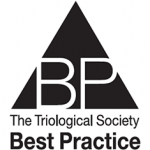TRIO Best Practice articles are brief, structured reviews designed to provide the busy clinician with a handy outline and reference for day-to-day clinical decision making. The ENTtoday summaries below include the Background and Best Practice sections of the original article. To view the complete Laryngoscope articles free of charge, visit Laryngoscope.
BACKGROUND
Tracheostomy is one of the most commonly performed surgical procedures, particularly in adult, intubated, and critically ill patients. Although the traditional technique includes an open surgical tracheostomy (OST) in the operating room, it is occasionally performed at the bedside. Over 30 years ago, endoscopic percutaneous dilatational tracheostomy (PDT) emerged as an alternative to OST for adult intubated patients. A very few early reports of PDT described major complications. These small studies suffered from poor patient selection, inappropriate indications, and flawed technique. This led to the belief that PDT was “a dangerous procedure with potentially catastrophic complications”. Indeed, since these early reports, PDT has been the subject of intense controversy, particularly in the otolaryngology–head and neck surgery community. The senior author published a series of 500 PDT cases as a Triological thesis in 2005, outlining key steps to assure the safety of the procedure (Laryngoscope. 2005;115(10 Pt 2):1-30) These included a list of absolute contraindications, which include pediatric tracheostomies, patients with unprotected airways, emergency airway situations, midline neck masses, and inability to palpate the cricoid cartilage.
BEST PRACTICE
The current literature unequivocally demonstrates that endoscopic PDT is at least as safe as OST, with additional advantages including a decrease in operative time and perioperative wound infections. The current literature suggests PDT may additionally carry a lower rate of long-term complications, though these remain notoriously difficult to study. Mortality and early perioperative complications including hemorrhage are comparable between both techniques. PDT is an attractive alternative to OST in adult, intubated critically ill patients by clinicians, and should be included in otolaryngology–head and neck surgery training programs.
